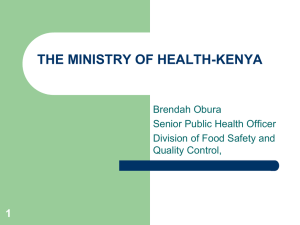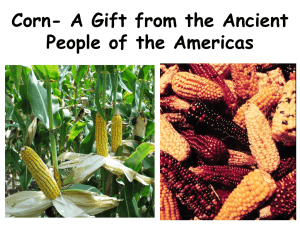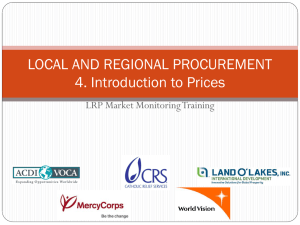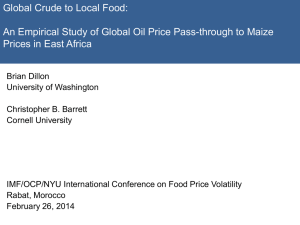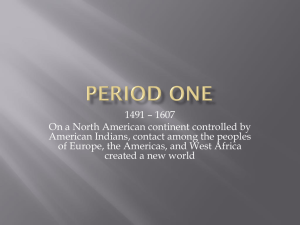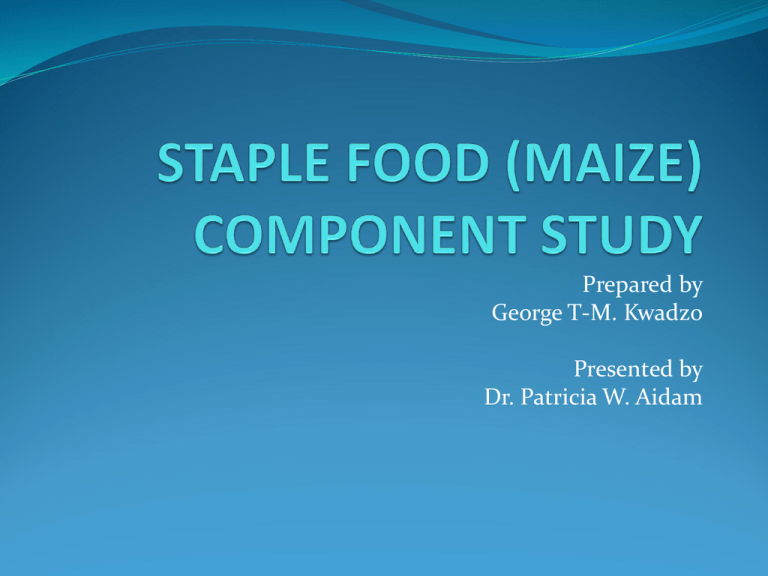
Prepared by
George T-M. Kwadzo
Presented by
Dr. Patricia W. Aidam
Introduction
Maize is the most important cereal crop on the
domestic market in Ghana
the 7th largest agricultural commodity in terms of
value of production over the period 2005-2010
accounting for 3.3 percent of total agricultural
production value.
Maize accounts for 55 percent of grain output followed
by paddy rice (23 percent), sorghum (13 percent) and
millet (9 percent).
Introduction
Maize is also an important component of poultry
feed as well as a substitute for the brewing
industry.
Maize average yield registered in 2010 was 1.9
Mt/ha against an estimated achievable yield of
around 2.5 to 4 Mt/ha resulting in 76 percent
achievement level.
Not possible to explain to what extent production
increase was due to any of these: favourable rain
patterns, the introduction of the fertilizer subsidy
in 2008, and high food prices.
MAIZE SUPPLY
Maize is the largest staple crop in Ghana and accounts
for 50-60% of total cereal production.
Maize is one of the most important crops for Ghana’s
agricultural sector and for food security.
Majority of maize is produced by smallholder farmers
under rain fed conditions.
Maize production in 2010 amounted to about 1.9 million
MT.
MAIZE PRICES TRENDS
Ghana’s maize market did not escape the commodity
price crisis that engulfed global commodity markets in
the 2007 to 2010 period.
The price range in the 2007/08 crop year, for example,
was GH35.35 per 100kg compared to GH12.51 in the
previous crop year and GH17.91 two crop years later.
Summary Statistics of Monthly Maize Prices
(2006/07‐2011/12) per 100kg Bag
Crop year Months
Range
Minimum Maximum
Mean
Standard
deviation
Coefficient
of variation
2006/07
12
12.51
16.58
29.09
23.26
4.24
18.2%
2007/08
12
35.35
24.63
59.98
36.03
11.76
32.6%
2008/09
12
28.49
41.15
69.64
54.42
9.79
18.0%
2010/10
12
17.91
43.15
61.06
49.69
4.95
10.0%
2010/11
12
28.30
43.10
71.40
53.02
8.75
16.5%
2011/12
6
22.42
58.12
80.54
71.05
8.79
12.4%
MAIZE DEMAND/CONSUMPTION
It is estimated that 85 percent of all maize grown in
Ghana is destined for human consumption and the
remaining 15 percent is used for the animal feeding
sector (mainly poultry).
Data obtained from major feed mills in Ghana
suggests that about 250,000 MT of maize is used for
poultry feed annually.
MAIZE DEMAND/CONSUMPTION
A deficit of around 115,000 metric tons has been
registered in the year 2010
Based on the most recent domestic production data, the
shortfall between domestic production and domestic
consumption would reach 267,000 MT by 2015 without
further productivity improvement (MOFA 2011).
This deficit will mostly affect consumers in the urban
areas and the poultry industry.
MARKETING AND TRADE
Domestic maize trade relies largely on a network of
traders linked by personal and ethnic ties.
“Market Queens”, women engaged in maize trading
dominate the local and regional markets while larger
groups of wholesalers engage in spatial arbitrage across
regions/districts.
In the Techiman district wholesalers normally obtain
their maize either directly from farmers with whom they
have long standing relationships or from district
assemblers, brokers.
MARKETING AND TRADE
Techiman serves as one of the main feeder markets in
Ghana
The other important feeder market for maize is Tamale
located in the Northern Region.
Ghana is almost self-sufficient in white maize. The small
volumes imported are mainly if not entirely constituted
by yellow maize which is used in the poultry feed industry
Maize is also exported, but often through informal
channels, and hence not captured by official data.
MARKETING AND TRADE
Official statistic available suggest Ghana’s main
trading partner in West Africa is Cote d’Ivoire while
Argentina was the maize exporter during the 20052010 period.
POLICY DECISION AND MEASURES
Interventions in the maize sector: fertilizer subsidy,
mechanization programme, block farm programme
and the buffer stock scheme.
Fertilizer subsidy:
Introduce 50% fertilizer subsidy in 2008
Fertilizer agents sell fertilizer at fixed price in each
region
Government absorb the operational cost on fertilizer:
port handling charges, loading and transport costs as
well as commission and margins
POLICY DECISION AND MEASURES
Programme revised in 2010 by replacing the voucher
based system with the waybill system due to high
administrative and overhead costs
Subsidy amounted to GHS25.3 million in 2008and rose to
GHS37 million on 2010/2011.
Fertilizer import has grown significantly over the last five
years.
Coupled with the introduction of the fertilizer subsidy
programme the government has liberalized the fertilizer
market.
POLICY DECISION AND MEASURES
There is no import duty and VAT on all types of fertilizers.
But there are administrative fees and levies:
an inspection fee (1 percent of CIF),
a processing fee (1 percent of CIF for zero rated products), a network charge – GCNet (0.4 percent of FOB), -National
Health Insurance levy (2.5 percent of CIF), -an ECOWAS
levy (0.5 percent of CIF) and - an EDIF (Export
Development and -Investment Fund levy) (0.5 percent of
CIF)
The total is approximately 5.9% of the CIF fertilizer value.
Mechanization Programme:
Government is providing tractors to producers for
mechanizing farming.
Aim is to increase yield of maize from 1.89 MT/ha in
2010 to 2.5 MT/ha in 2012
Provision made through the Agricultural Mechanization
Services Enterprises Centre (AMSEC) owned by the
private sector
84 AMSEC are oprational
Mechinery allocated to AMSEC operators included
tractors and its matching implements, maize shellers, and
water pumps.
The allocations were based on machinery requirements of
the AMSECs operators and their ecological locations.
It is planned that all districts in the country will have at
least one functional AMSEC in future
The extent of achievement will be assessed in this study.
Block Farms:
The Block farm programme was piloted in 2009 in six
regions – Ashanti, Brong Ahafo, Central, Northern, Upper
East and Upper West
Aim at promoting farming as a business
Bring a group of interested farmers to work together and
received range of services including fertilizer subsidy,
mechanization services and extension.
The extend to which the aims of the intervention has been
achieved by introducing competition in the area is the focus
of this study.
National Food Buffer Stock Company:
In 2010, the government set up the NAFCO.
NAFCO is to buy, preserve, store , sell and distribute excess
in warehouses across the country.
NAFCO is the engage in grain marketing and stabilize
supply and price of maize.
NAFCO keeps two kinds of stocks – operational stock and
emergency stocks
The emergency stock are used to manage emergency food
situations that may occur.
Maize (producer prices) are fixed by NAFCO.
NAFCO uses produce buying companies to purchase
maize from farmers
The study will assess the extent NAFCO operations
have impacted the maize market, market actors and
helped aggress emergency situations
TRADE POLICY
Signed Common External tariff (CET) yet not implemented
in any WA country including Ghana.
Maize imports are charged a 20 percent import tariff.
Maize imports are subject to restrictions, a license is
required to import Maize.
Ghana sometimes blocks the duty-free importation of goods
originating in ECOWAS by applying a wide range of
additional taxes, levies and fees.
Trade status of maize:
Ghana is self-sufficient in terms of white maize production
and consumption, but remains a net importer of yellow
maize that is mainly utilized by the animal feed industry.
The main import suppliers of white maize are South Africa
and or Cote d’Ivoire, while the US and Argentina are yellow
maize exporters
The choice of yellow or white maize prices as the
benchmark price appears not to be so relevant. For example,
the spread between monthly spot prices of white and yellow
maize traded on SAFEX is very close to zero
Benchmark prices of maize (CIF)
It was decided to take the average implicit CIF import prices
of maize from those countries that result being the main
exporters to Ghana in each of the years considered in the
analysis
Other values for a more reliable estimate of unit values of
maize imports are under consideration, including CIF
prices for maize in neighbouring countries.
Domestic Maize Prices
Maize price data exist for wholesale and retail Accra
(maize deficit and consuming area) and
wholesale/producer Techiman (maize producing area).
The most representative channel for maize in Ghana is
that of production taking place in central and northern
districts and internal trade to major deficit areas, the
main ones being the cities of Accra and Kumasi.
While wholesale prices exist, it is unclear which data
series is available and for what period.
The price observed at the Techiman market is not
representative of the producer/farm gate price since a
small number of producers bring their maize direct to
the market and those who do come to the market incur
transaction costs over and above the farm gate value.
Exchange Rates
Ghana has a floating exchange rate regime for its
currency, the Ghana Cedi
With the 2006 foreign Exchange Act Ghana shifted away
from exchange control.
The exchange rate between the cedi and the USD will be
obtained from the Bank of Ghana for the relevant
period.
MARKET ACCESS COSTS
From farm gate to wholesale
Observed access costs between the farm gate (Techiman)
and the wholesale markets (Accra & Kumasi) will be
computed based on maize access costs for the purpose
calculating market incentives and disincentive for maize.
From border to point of competition
Information on imported maize will be obtained from SRID
and CEPS on VAT, insurance levy, the destination and
inspection fee, the ECOWAS levy and the EDIF levy for the
analysis.
To estimate the import parity price, the share of
each cost item, including transport, handling,
taxes and levies will be applied to the CIF maize
price for each year over the period of analysis
where data is available
Apart from the VAT and NHIL which are also
applied on domestically produced goods, taxes
and fees such as the destination inspection fee
(1%), the ECOWAS levy (0.5%) and the EDIF levy
(0.5%) penalize imported goods and can be
considered additional import duties and
subtracted from observed costs.
Quality and quantity adjustments
The need for quality adjustment between imported yellow
maize and domestically produced white maize will be
considered depending on information gathered from MOFA
and the Ghana Statistical Service (GSS).
Data Required
CIF Benchmark price
Domestic price at point of competition
Domestic price at farm gate
Exchange rate
Access cost to point of completion
Adjusted access cost to point of competition
Access cost to farm gate
Quality adjustment on border white maize
ESTIMATION OF INDICATORS
Two observed nominal rates of protection, one each at the
wholesale and farm gate level are first computed.
NRPofg = (Pfg –RPofg)/RPofg;
NRPowh = (Pwh –RPowh)/Rpowh
The NRPofg capture all trade and domestic policies, as well
as other factors which impact on the incentive or
disincentive for the farmer/producer.
The NRPowh helps identify where incentives and
disincentives may be distributed in the maize market chain
The second the Nominal Rates of Protection –adjusted
(NRPa) in which the reference prices are adjusted to
eliminate distortions found in the Ghanaian maize
market supply chain.
NRPafg = (Pfg –RPafg)/RPafg;
NRPawh = (Pwh –RPawh)/Rpawh
Market development gaps caused by market power,
exchange rate misalignment, and excessive domestic market
costs add to the NRPo to generate the NRPa indicators.
PERCEPTION SURVEY
A perception survey is a study with the goal of collecting
impressions about a program or issue.
The primary distinction of a perception survey is that it is
intended to discover opinions rather than factual data.
Questions can be presented as yes/no or multiple choice,
or participants could be given a scale of descriptors, such
as "very satisfied, satisfied, indifferent, dissatisfied" from
which to choose.
Other questions may be open-ended, so that the
respondent can answer in his/her own words
In this study the intention is to capture the perception
and opinions of market actors on the impact of reform
measures in the maize sub-sector on incomes, availability,
access and welfare.
These findings can tell policy makers what
consumers/market actors like and don't like, whether or
not they trust the state and whether they would
recommend the continuation of the policies.
As with many surveys, perception surveys routinely
include demographic questions, such as age, sex,
educational level, income level, location, market actor
etc so that data can be more easily sorted.
THANK YOU




